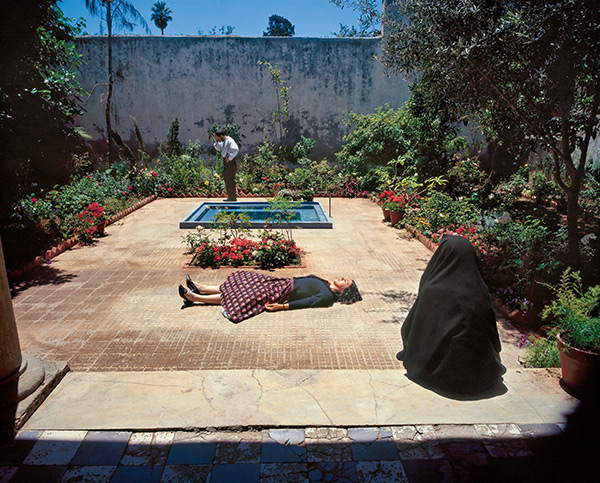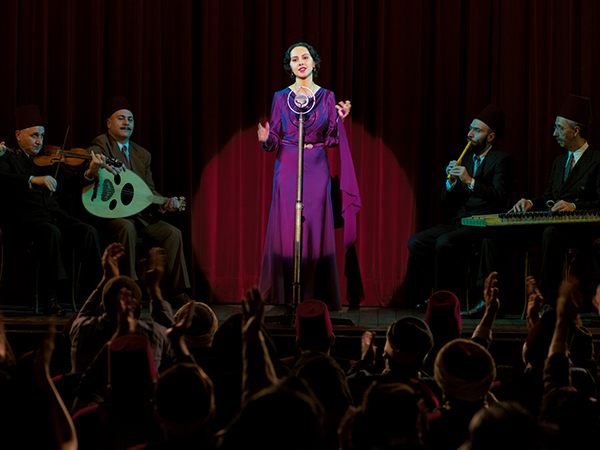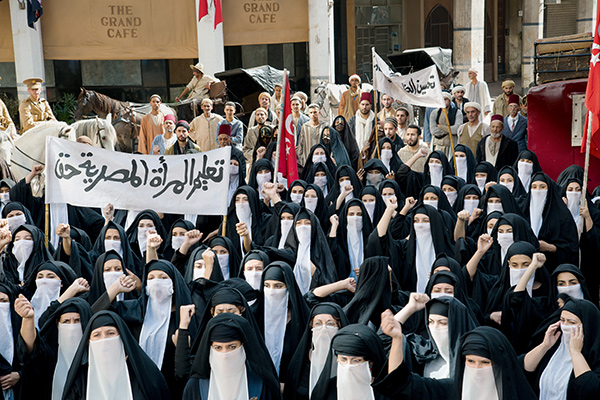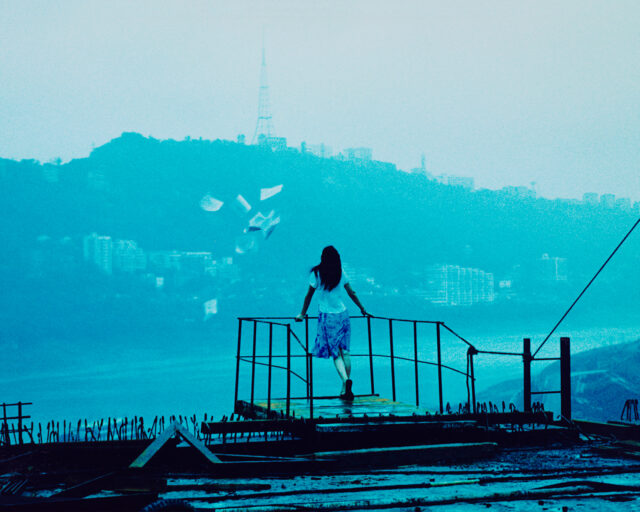Shirin Neshat’s Dreamlands

Shirin Neshat, Still from Looking for Oum Kulthum, 2017
© the artist and courtesy Gladstone Gallery, New York and Brussels
Shirin Neshat is an image maker of ample gifts. Born in Qazvin, Iran, she moved to California in 1974 to study art. In 1990, eleven years after the (fateful) Iranian Revolution, she returned to Iran and soon began work on her debut photographic series, Women of Allah (1994). Like poetry to decipher, these stark black-and-white portraits of women, many of whom have text inscribed on their bodies, offer up complex emotional registers. Some of her subjects carry firearms, evoking a battle recently waged, or a battle to come. Since then, Neshat’s work has taken a zigzag journey from photography to video installation and, finally, to cinema.
Few artists have made such a seamless transition to creating feature films, and yet Neshat makes her restless movement between forms appear natural—necessary, even. From one work to the next, the aura of Neshat’s distinctive signature remains. Some critics have burdened her work with the specter of speaking for or about the fates of women, or women from the Middle East in particular. But a true accounting of Neshat’s art, and the rich range of her references, reveals that ambiguity is the land in which her work resides. As a self-described nomad, Neshat says, “we have this ability to approach different places and people and subjects and make them our own.”

Shirin Neshat, Stills from Women Without Men, 2009
© the artist and courtesy Gladstone Gallery, New York and Brussels
Negar Azimi: Shirin, as an artist you’ve brought images into the world that are burned into the mind. They’re literally stuck—certainly in my own. They’re images of such iconicity, of such jaw-dropping beauty and enigma. I’m thinking, for example, of the stark juxtaposition of the male and the female singer in Turbulent. Or Rapture, in which you see women marching defiantly into a murky sea. Your gift for composition is significant, and you’ve created a visual vocabulary that I think is all your own. Where do these images come from?
Shirin Neshat: I think that at root I’m an image maker and the images I’m drawn to are paradoxical, full of contradictions. Perhaps the only way I can explain it is that this is how I feel about everything around me. I feel like I’m full of contradictions, life is full of contradictions, and there’s a good and bad in everything. I never see anything in between.

Shirin Neshat, Still from Looking for Oum Kulthum, 2017
© the artist and courtesy Gladstone Gallery, New York and Brussels
Azimi: Your images are emotionally potent, but ambiguous too. Those women marching into the sea—are they running away from something? Or are they walking into the sea because they want to? Is the woman in the unforgettable first scene of Women Without Men flying, or is she in fact falling? That ambiguity is part of the power of your visual language.
You made an evolution from being a still photographer to authoring filmic videos and video installations. Now you make cinema. First, can you tell me a little about how you came to be a photographer?
Neshat: I guess I’ve become very good at building a profession out of things that I’ve never studied or had formal training in. This doesn’t mean that I’m naturally talented at any of them! But I do have a tendency to experiment. When I was making the series Women of Allah, I was not a photographer, but I was really struck by the power of the photojournalism that had documented the Iranian Revolution. No painting, sculpture, movie could have captured the spirit of the religious fervor.
Then, slowly, I moved from making images that had this borderline photojournalistic approach to storytelling, but without really knowing how to do it. I think the video installations in some ways prepared me. Videos like Rapture or Turbulent were like moving photographs; there was no real logic of filmmaking to them. Slowly, I had a protagonist. Then I had a beginning, middle, and end. There was a real director behind the vision. Over time, my work became more cinematic, and I felt like trying to tell a story rather than just create an environment. That led to my first entry into filmmaking, which was Women Without Men (2009).

Shirin Neshat, Still from Women Without Men, 2009
© the artist and courtesy Gladstone Gallery, New York and Brussels
Azimi: You note that images of the Iranian Revolution of 1979 were consequential, and somehow led you to the medium of photography. I immediately conjure Abbas’s haunting photographs of the revolution and its aftermaths, and Bahman Jalali’s too. But outside of that moment, what was your visual coming of age like? What marked or influenced you?
Neshat: Most of my young adulthood was spent in the United States, so my education was very much Western. I was away from Iran for so long, and was out of touch with what was happening there culturally. I was most influenced by American or European photographers, and Western art history. Later, I started to go to Iran. I was curious about the revolution and the changes taking place in my family. I spent a lot of time speaking to friends who had become involved with the revolution. But I wasn’t really in dialogue with artists. My family wasn’t really artistic.
When I came back to the United States, I worked at the Storefront for Art and Architecture, and I was around people like Kiki Smith, Mel Chin, Vito Acconci, and David Hammons. My mind and life were divided, literally, between the bohemia of New York and what was going on politically in Iran.
Later, my life changed again. I now had an Iranian partner, my collaborators became Iranian, and I studied Iranian cinema. I began to see the similarities and differences between how I made sense of the revolution and its legacies, and how those who had lived in Iran made sense of it all. I saw a vast difference. I have a more diasporic or exilic … a kind of accented point of view. And a very Western, absolutely conceptual approach—never, ever to do with realism. So what I’m trying to say is that my New York life had everything to do with the evolution of my ideas. My subjects were Iranian, but I was never really inspired or influenced by Iranian artists.

Shirin Neshat, Still from Looking for Oum Kulthum, 2017
© the artist and courtesy Gladstone Gallery, New York and Brussels
Azimi: The question of influence is endlessly interesting. At the moment I’m thinking about the late avant-garde theater director Reza Abdoh, who was also of Iranian American background. And not unlike with your own work, there are many competing claims on his. Some say that his work was influenced by aspects of Shia Islam, like the Ta’ziyeh passion play. Others look at it through the lens of Artaud and his theater of cruelty. And yet others argue that it’s just deeply American, more informed by American TV than anything else. So the question is, can it be all of these things? Can one’s work be a collage, especially for someone like you with, as you said, an exilic background, a sort of pastiche of influences?
Neshat: Influence is such a mystery. I do believe there are elements in my work that have to do with my experience as a kid in Iran. I left when I was seventeen. But I feel like that Iranian part of me has deeply informed my work nonetheless, even though I’m very American too.
To continue reading, buy Aperture, Issue 231 “Film & Foto,” or subscribe to Aperture and never miss an issue.

























